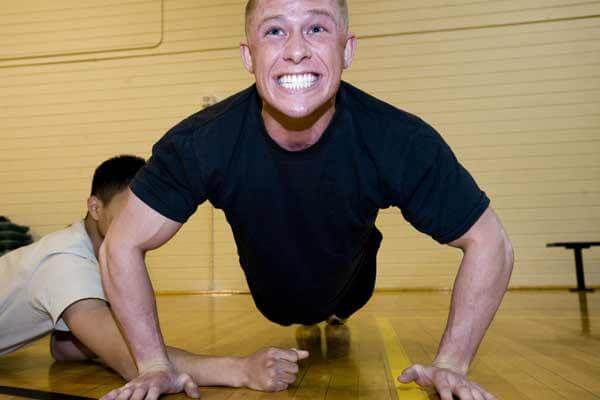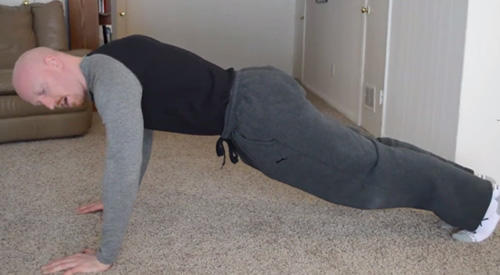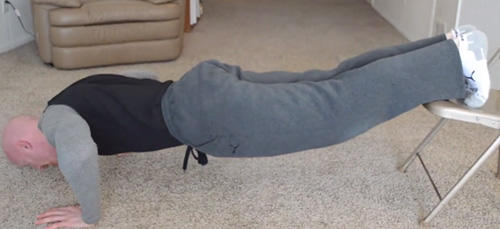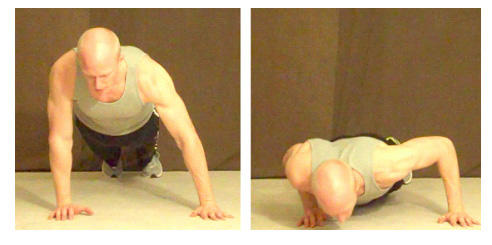
On May 5th, 2015, U.S. Marine George Hood broke the world record for the longest time someone could hold a plank. At the age of 57, he held this position for five hours, 15 minutes, and 15 seconds.
The feat was impressive to say the least, and was used to help raise funds for the Semper Fi Fund, a charity for injured U.S. service members.
Anyone looking at this feat and wanting to build muscle might think, "Wow! I want to try to increase my plank time, or amount of pushups, or total squats I can perform."
Unfortunately, these ideas are misguided because those exercises are not the way to stimulate muscle growth.
The amazing feat George Hood performed showed off his muscular endurance, not his muscle mass.
One of the most common mistakes beginner bodyweight enthusiasts make is to think increasing their repetitions will increase the size of their muscles.
They set goals like, "I'll do 100 pushups in a row," and think they'll develop a strong muscular chest in the process.
That's not how it works.
In this article, I'd like to share with you three of my top methods for building muscle size using only bodyweight exercises.
But before we do that, we must first talk about the physiology of muscle growth.
Why Don't High Repetitions Build Muscle?
When you perform high repetitions of any exercise (weights or bodyweight), you are telling your body that endurance is needed. Think about the physiques of marathon runners or Tour de France cyclists. They are lean.
Physiologically, the blood vessels in their body have adapted to transport oxygen to and from their muscles very efficiently, which is how they can run or cycle for long periods of time and distances.
In order to build muscle mass, you must fatigue the muscle within a low rep range. Think about how bodybuilders train. They don't grab light weights and do 50-100 reps. They grab heavy enough weights so that they struggle to perform their 10th, 11th, or 12th repetition.
The muscle then adapts and gets bigger.
When doing bodyweight exercises for muscle growth, you have to use the same strategy. You must fatigue the muscle in a low rep range.
How do you do that? With these three strategies.
Bodyweight Muscle Strategy #1: Angular Training
Angular Training will help you target muscles that you don't normally target, thereby forcing you to fatigue within a low-rep range.
Let's take the push up as an example. See the image below.
 |
In order to perform the standard push up you keep your feet on the ground. You lower yourself down until your chest almost touches the ground then push back up.
This exercise works the middle portion of your chest.
However, there is a way of modifying the exercise to make it even harder and help you fatigue within a low rep range (targeting muscle growth).
 |
See the exercise below called a Decline Push Up. This exercise targets the upper portion of the chest which doesn't usually get worked. You adjust the angle of your body in order to fatigue a different area of the same muscle group.
When you perform your next workout, try adjusting the angle of your body and you'll notice muscles that aren't normally worked.
Bodyweight Muscle Strategy #2: Bodyweight Distribution
Bodyweight Distribution is one of the most effective methods of adding size to your body. Let's take the normal push up again as an example.
Typically, people perform the push up with their weight evenly distributed. 50% of their weight is on one arm, and 50% is distributed on the other arm.
What would happen if you shifted your weight more to one side or the other?
Answer: the pushup would get much harder.
 |
You'll notice that about 70% of my upper body weight is distributed on my right arm. As I go through the push up, I keep this weight distribution and focus mostly on my right pectoral.
When I fatigue fully with this side, I switch to the other side.
Why does this technique work so well? You are essentially "adding weight" and making the exercise harder like a bodybuilder would, but you're doing it through simple bodyweight distribution instead of increasing the load on your weights.
The Bodyweight Distribution technique can be applied to many exercises such as:
- Pull Ups
- Chin Ups
- Diver Bombers
- Bridges
- Squats
- And so many more…
Bodyweight Muscle Strategy #3: Variable Rest Intervals
Variable Rest Intervals are a great way to force your muscles to get bigger.
As mentioned above, when you perform a high number of reps, you end up training for endurance, not muscle hypertrophy (growth). Variable Rest Intervals [VRIs] help you fatigue within a low rep range.
Here's how to do it.
Let's take the push up as an example again. On the first set, you'd perform your maximum number of repetitions. Say for example, 40 reps. Normally you'd wait 60-90 seconds to rest and then crank out another 35-40 on set 2. With VRIs, you adjust your rest period between sets to make sure that you fatigue within a low rep range of about 8-12.
Instead of resting for 60-90 seconds, you'd rest for only 10. This next set, for example, only allows for 8 reps.
So you rest for only 10 seconds again, and in the 3rd set you max out at 6. This is too low, so you decide to give yourself 20 seconds of rest. On the 4th set you knock out 12. Perfect!
With VRIs you keep adjusting your rest time so that your body doesn't fully recover from the last set, thereby forcing it to fatigue within a low rep range.
Conclusion
If you are trying to build muscle using only bodyweight exercises you can't simply do more of the same thing you've always done. U.S. Marine George Hood was able to hold the plank for over five hours. This shows tremendous muscular endurance, but it's not the way to build muscle size.
In order to build size, you have to fatigue the muscles in a low rep range. You can start using the three techniques above: Angular Training, Bodyweight Distribution and Variable Rest Intervals to pack on muscle without weights.

Todd Kuslikis is the founder of AShotofAdrenaline.net, a bodyweight exercise site that helps people build muscle and strength using only bodyweight exercises. He has created many bodyweight based training routines including his most popular 3 Month Bodweight Training Plan.
For more information on calisthenics and bodyweight-based training, check out his site.
© Copyright 2017 Albuquerque Journal. All rights reserved. This material may not be published, broadcast, rewritten or redistributed.
Original article and pictures take www.military.com site
Комментариев нет:
Отправить комментарий